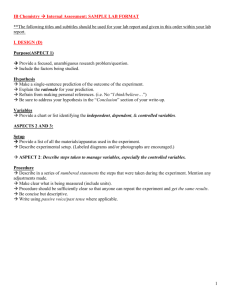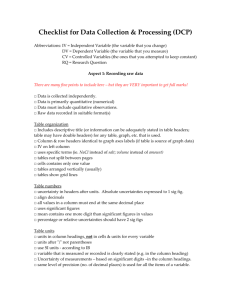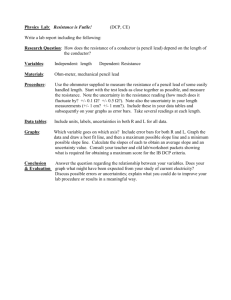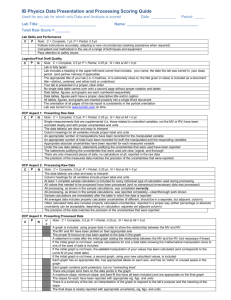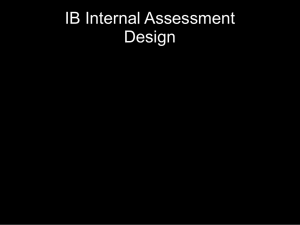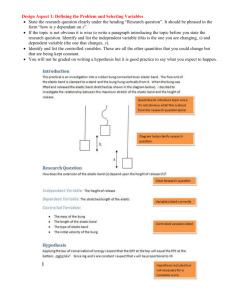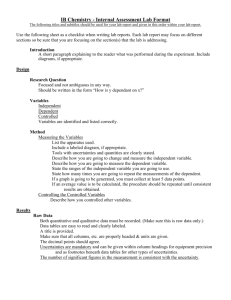writing a good ess - The Newman School
advertisement
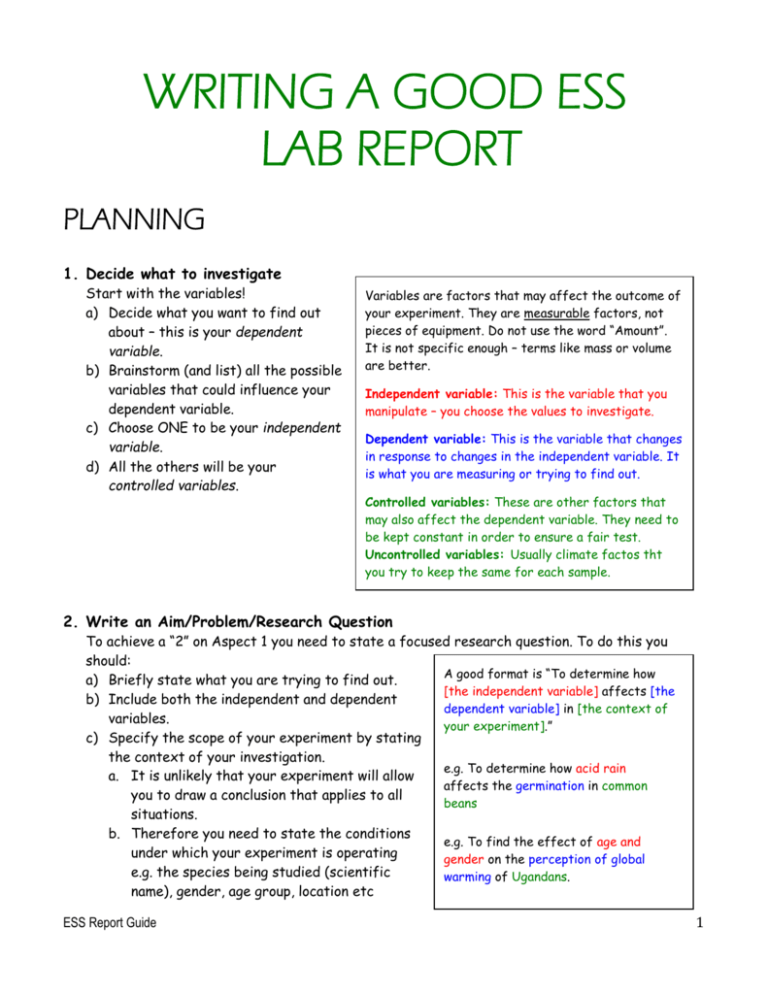
WRITING A GOOD ESS LAB REPORT PLANNING 1. Decide what to investigate Start with the variables! a) Decide what you want to find out about – this is your dependent variable. b) Brainstorm (and list) all the possible variables that could influence your dependent variable. c) Choose ONE to be your independent variable. d) All the others will be your controlled variables. Variables are factors that may affect the outcome of your experiment. They are measurable factors, not pieces of equipment. Do not use the word “Amount”. It is not specific enough – terms like mass or volume are better. Independent variable: This is the variable that you manipulate – you choose the values to investigate. Dependent variable: This is the variable that changes in response to changes in the independent variable. It is what you are measuring or trying to find out. Controlled variables: These are other factors that may also affect the dependent variable. They need to be kept constant in order to ensure a fair test. Uncontrolled variables: Usually climate factos tht you try to keep the same for each sample. 2. Write an Aim/Problem/Research Question To achieve a “2” on Aspect 1 you need to state a focused research question. To do this you should: A good format is “To determine how a) Briefly state what you are trying to find out. [the independent variable] affects [the b) Include both the independent and dependent dependent variable] in [the context of variables. your experiment].” c) Specify the scope of your experiment by stating the context of your investigation. e.g. To determine how acid rain a. It is unlikely that your experiment will allow affects the germination in common you to draw a conclusion that applies to all beans situations. b. Therefore you need to state the conditions e.g. To find the effect of age and under which your experiment is operating gender on the perception of global e.g. the species being studied (scientific warming of Ugandans. name), gender, age group, location etc ESS Report Guide 1 3. Identify the variables Make sure you have read the information on variables (textbox in Step 1). In order to achieve a “2” for Aspect 1 you must: a) State the independent. b) State the levels of the independent variable Example for Step 3f. that will be tested (see step 5a for more Controlled Method to control the information). variable variable c) State the dependent variable. Temperature The test tubes in which d) State how the dependent variable will be at which the reaction occurs will measured (if it can’t be measured directly). reaction be placed in a water bath e) List several controlled variables. occurs set to 40C for the duration of the reaction. Aspect 2 requires that you explain the method Duration The reaction will be you will use to control each of the (controlled) (time) of the allowed to proceed for variables. reaction 300 seconds. This will be f) Give brief (but specific) explanation of how timed using a stopwatch (0.1seconds). you will control (keep at a constant value) each variable. Including this in the variables section ensures that you have considered each of the controlled variables. However, it should ultimately appear in the method. g) If a variable cannot be controlled, state this. Then describe how you will try to minimize any change and/or how you will monitor the variable. See Appendix 1 for uncertainties to consider. 4. List the equipment (apparatus and materials) needed Choosing appropriate equipment will allow you to achieve a “2” for Aspect 2. Make sure that your equipment list includes all of the following: a) All of the equipment and materials needed for the experiment (after writing you method read through it and check of the items used as you go on your equipment list) b) Numbers of items (e.g. 2 petri dishes) c) Volumes and concentrations of any solutions needed (e.g. 300ml of 0.5M hydrochloric acid) d) Precision (and range if appropriate) of all measuring instruments. How precise do you need to be in your measurements? e) Sizes of beakers or other items (e.g. 250ml beaker, 10cm length of dialysis tubing) 5. Plan and write a method/procedure Planning a Method Aspect 3 of Planning assesses your ability to collect sufficient relevant data. The following considerations are important to ensure that you collect enough data and that the data will help to answer your AimESS Report Guide Number of Values If you are looking for a correlation, at least 5 different values are needed (the more the better). If you are comparing two different situations, 3 values will be sufficient. 2 a) What values of the independent variable should you test? i. How many values should you test? Decide how many values will be needed to show any trend or pattern. Plan for an ideal situation – worry about time constraints later. Usually 5. ii.What is an appropriate range of values? Range of Values You may need to do some research to help you decide. e.g. if testing acidic rain solutions then you would want to test values around 5.6pH. If you are investigating chemical spills in you might want lower pH values b) How will you measure your independent and dependent variables? a. Can you measure it directly (raw data) or do you need measure other values (raw data) and use them to calculate values (processed data) for your independent variable? b. What measuring instruments will be best to use? Do you know how to use them? Number of Trials c. What level of precision is required in your All systems, because of their measurements? complexity and normal variability, require replicate d. What units will you use to record your observations and multiple measurements? c) How may trials or replicates need to be carried out? a. Consider how you are going to process your data b. Now go back and double check that you have collected enough of the right types of measurements. Plan for an ideal situation – worry about time constraints later. samples of material. Remember that a minimum of 5 values is needed for calculating means and standard deviations. Other statistical tests have other requirements e.g. Spearman’s Rank requires at least 30 values. d) Will any calibration of equipment need to be carried out to avoid any errors and uncertainties in taking measurements? How will this be done? Write the Procedure A clear, easy to follow method is necessary to achieve a “2” on Aspects 2 and 3. Think about method you have seen and what information you like to have! Someone (who has not done the experiment before) should be able to follow your procedure and obtain similar results. The following features contribute to writing a good method. d) The method can be written as instructions like a recipe e) Do not begin with “Gather all of the materials” … it is kind of a given that you will do this!! f) Use numbered steps (rather than paragraphs). g) Use a diagram if possible to show how to set up any equipment. Then you can say “Set up the equipment as shown in the diagram”. This would save you writing a lot of words. h) Specify what will be measured (and the units to be used) i) Include details of how you will measure values ESS Report Guide 3 DATA COLLECTION AND PROCESSING RAW DATA refers to the values obtained from the measuring instruments exactly as they were shown. Once you do any addition, subtraction, multiplication or division then it becomes PROCESSED DATA. 1. Record you raw data The recording of raw data is necessary to address Aspect 1. If the data you record is not RAW data Quantitative data – numerical values obtained you will receive a “0” for this section. Raw data should include quantitative (always!) and qualitative (usually appropriate) data. Raw data should be displayed in a table (qualitative data may require some other format, but a table is still usually best). In constructing a data table you should consider the following features: from the measuring instruments (e.g. temperature, mass etc) or by other means e.g. counting Qualitative data – non-numerical observations. Other observations made during your experiment that may have a bearing on the conclusion or help to explain patterns and trends (or the lack of!). Examples include changes in colour, texture, size etc Any other observed sources of error should also be recorded. a) Structure a. When possible, the independent variable should come first in your columns followed by the dependent variable. b. Show lines around all rows and columns c. Make it clear. A good table should be able to be understood out of context (i.e. not embedded in a lab report describing the experiment) b) Title a. Title should be descriptive of the data contained in the table. It should include the key variables as well as any specific conditions of the experiment b. Should be numbered consecutively throughout the report with a specific identifying title. EXAMPLE Table 1: The relationship between temperature and water uptake in a leafy shoot of a geranium (Geranium carolinianum) c) Headings a. Columns should be clearly annotated with a heading, units (in heading not body) and uncertainties if relevant. Headings should indicate what the data is in the column below b. Headings are likely to be the name of a variable ESS Report Guide 4 d) Units a. Units should be included with a heading (not next to each data value in the table) e) Uncertainties a. These will only apply for controlled experiments that are carried out in the lab. In field work (and some lab based experiments) the uncertainties in measuring instruments are likely to be insignificant compared to the natural variability of the system you are working with. b. All measurements have uncertainties and you should indicate them in your data tables. Uncertainties should be associated with all raw data and an attempt should always be made to quantify uncertainties. In IB Uncertainties ESS the accuracy of a measuring instrument is The smallest division on a equal to the smallest unit of measurement. Plus particular ruler is 1mm. The or minus () this value is what you should record uncertainty could be recorded as your uncertainty. as 1mm or 0.1cm c. Remember that only measurements obtained with a measuring instrument have uncertainties. e.g. Counts do not have an uncertainty d. Uncertainties should appear with the units in the column heading f) Precision of data a. There is no variation in the precision of raw data; the same number of decimal places (significant figures) should be used. g) Anomalous results – any results that are particularly different from the others need to be identified and excluded from any processing. You must clearly state this. Further advice on drawing data tables can be found at: http://www.saburchill.com/IBbiology/sci_invest/006.html 2. Process your data Data processing involves combining and manipulating raw data to determine the value of a physical quantity (adding, subtracting, squaring, dividing), and taking the average of several measurements and transforming the data into a form suitable for the graphical representation. Simply plotting raw data is not considered processing. If the raw data is already in a form suitable for graphical presentation, it is not considered processing unless a line of best fit/trend line is drawn. a) Look at Your Aim ALWAYS CONSIDER YOUR AIM. The purpose of processing data is to show patterns in the data that help you draw a conclusion that answers your Aim (not to pad out a lab report!). Aspect 2 requires that any processing helps in answering the Aim. ESS Report Guide 5 b) Choose Your Processing Technique In Aspect 2 you will be assessed on your ability to choose appropriate processing techniques (types of calculations) and to carry out those calculations correctly. Some appropriate options for data processing in biology are: i. Change in quantities (initial final) o This is a very basic processing technique and should be used in combination with other methods. Change in quantities Final Initial ii. Percentage change in quantities. o This also allows you to compare quantities that have different initial and final quantities Percentage change in o This often more appropriate than change in quantity quantities as it helps to eliminate some of the error. Final Initial 100 o For example, since it is almost impossible to obtain Initial slices of potato that are the same dimensions, same consistency throughout, and the same mass to the degree of precision that your instruments allow, it is more appropriate to do a percentage change in quantity rather than simplechange in quantity calculations. iii. Rate o Rate is a measure of how quickly a variable changes Rate Final Initial TimeTaken iv. Mean and Standard Deviation o Whenever you have multiple trials in an experiment, it is good practice to calculate the mean and standard deviation. o Using the mean as opposed to individual values helps to minimize the error in your experiment. o Standard deviation also helps to indicate the spread of your values around the mean. A smaller standard deviation indicates that the values are clustered closely around the mean (and therefore possibly more reliable); a larger standard deviation indicates a wider spread (values are possibly less reliable). v. Percentage error Percentage error o This is used when comparing your TheoreticalValue ActualValue actual measurements to a 100 TheoreticalValue theoretical measurement. Percentage error describes the accuracy of measurements. You should always use percentage calculations as opposed to the numerical difference. This is because 10 cm error means nothing if you are measuring the distance between Shanghai and Beijing, but it is a huge error if you are measuring the length of a piece of paper. vi. Percentage deviation Percentage deviation ESS Report Guide AverageDeviation 100 Mean 6 o A measure of precision when a theoretical value is not known. This informs how reproducible your experiment is. vii. Correlation Coefficient o This can tell you the strength of a relationship between 2 variables. o Spearman’s rank is the most common one. c) Carry out your Calculations Make sure you go back and double-check your calculations. See section 3a to make sure that you have presented you work correctly d) Treatment of Uncertainties i) The uncertainties associated with the raw data should be taken into account. ii) Mean and standard deviation are acceptable ways of showing this in graphs with error bars. The mean should be the plotted point or height of the bar. For each point an error bar can be drawn that extends above the point/bar 1 SD and below the point/bar 1 SD. The size of the error bar is also an indication of the reliability of you data (and therefore any conclusion you draw from it) iii) The treatment of uncertainties in graphical analysis (scatter plots) requires the construction of appropriate best-fit lines. Further information on processing techniques (when and how to use them) can be found at: http://www.saburchill.com/IBbiology/stats/stats_hp.html http://moodle.wab.edu/mod/resource/view.php?id=3273 3. Present your processed data You are expected to decide upon a suitable presentation format without teacher assistance. Your ability to show how you processed the data, choose the correct presentation method and construct graphs etc will determine your level of achievement for Aspect 3. Important things to consider:- a) Present data so that stages to final results can be followed This will often mean showing your working for each type of calculation done (not for every single calculation done!). Each worked example should include the following: i) Heading describing the calculation ii) Formula iii) Identification of which set of data is being used in that example iv) Fully worked example v) If Excel or a graphing calculator was used to generate values (i.e. you didn’t have to plug numbers into an equation) it is OK to simply state this. In the case of Excel you should state the formula used. ESS Report Guide 7 vi) Flowcharts may also be appropriate here b) Significant Figures i) Inclusion of metric/SI units is expected for final derived quantities, which should be expressed to the correct number of significant figures. Your processed data should not have more significant figures (or decimal places) that the raw data you collected ii) All processed data should be to the same number of significant figures iii) Ensure that your processed data does not have more decimal places than the raw data c) Presentation formats A few general options are listed below; however, understand that you are not limited to these options as there are many processing options specific to certain labs such as population pyramids, and logarithmic graphs: i. Spreadsheets and tables showing data calculations such as mean, SD, percentage change etc. ii. Line graphs and scatter-plots showing continuous data points (e.g. time, GDP, age, distance, height etc.) with line of best fit iii. Bar graphs showing discrete data (categories) e.g. species, sex, ethnicity iv. Pie charts showing percentages out of 100% Diagrams and Tables vi. There should be clear, unambiguous headings for diagrams and tables or graphs similar to the heading used for tables in your data collection. vii. Diagrams will be labelled as figures. Figures should be numbered for reference and be placed below the figure it references. Graphs viii. Think about why you are drawing your graph …. It should be a visual representation of the data that allows you to answer the Aim. Therefore it should look like Dependent variable/ units Independent variable/ units ix. Graphs can be drawn by hand or using graphing software such as Excel (as long as you have had to make the decisions on the format, axes, scale etc). However, an inability to manipulate the program to show the necessary elements is not an excuse for failing to include them! x. Graphs must have the following: ESS Report Guide 8 Title. The same expectations apply as for table (see section on Recording Raw Data). Graphs will be labelled as figures. Figures should be numbered for reference and be placed below the figure it references. Appropriate scales; if you are measuring temperatures between 30 and 40 degrees, your graph should not begin and end at 0 and 100 respectively. Your units must be appropriate as well. If you are measuring in mm, you shouldn’t have meters marked on your graph. Think of a graph like a microscope; you want to see as much detail as possible. Labeled axes with units; axes should be labeled similarly to your table headings. Accurately plotted data points should be clearly shown A suitable best-fit line, trend line or curve is drawn (for a line graph or scatter plot) DO NOT CONNECT THE DOTS Further information on graphing can be found at: http://www.saburchill.com/IBbiology/graphs/001.html ESS Report Guide 9 DISCUSSION, EVALUATION AND CONCLUSION 1. Discuss, review and analyse your results a) Describe what your results show in the context of you topic of investigation b) Identify any trends or patterns in your results c) Compare these to literature, scientific understanding or models or class discussion. If there are differences, identify them and suggest possible reasons d) Identify any anomalous results and justify their exclusion from processing e) All literature used to write you lab report should be fully referenced by using MLA formatting to produce: a. Bibliography- Help on how to produce a bibliography can be found at http://owl.english.purdue.edu/owl/resource/747/07/ b. In-text referencing- advice on the correct format can be found at http://owl.english.purdue.edu/owl/resource/747/02/ 2. Discuss strengths and weaknesses in your investigation Aspects 2 and 3 require you to evaluate the procedure. Aspect 2 deals with Good format for Evaluation strengths and weaknesses in the Strength/Weakness Significance Improvement procedure and their impact on the results. This is where you comment on the design, method of the investigation, and the quality of the data. A good format for the Evaluation is shown to the right. In order to achieve a 2 on Aspect 2 you should: a) List specific strengths in the design and carrying out of the procedure. You could look at i. procedures, ii. limitations of equipment, iii. use of equipment, iv. management of time, v. investigation timing, vi. data quality (accuracy and precision) and relevance of data. b) List specific weaknesses in the design and carrying of out the procedure. Consider: i. procedures, ii. limitations of equipment, iii. use of equipment, iv. management of time, v. investigation timing, vi. data quality (accuracy and precision) and relevance of data. vii. See Appendix 1 for a discussion of errors ESS Report Guide 10 c) For each strength or weakness discuss its significance i.e. it’s effect on your results e.g. values too high/low, data values less reliable (large uncertainty/error/S.D. would indicate this), measurements less accurate or precise, trend/pattern incorrect or unclear etc Acceptable Example: “Because the simple calorimeter we used was made from a tin can, some heat was lost to the surroundings—metals conduct heat well. Therefore, the value we obtained for the heat gained by the water in the calorimeter was lower than it should have been. The heat lost from the tin can would not have been a lot in the time taken for the experiment so this probably did not have a significant impact on the results” Unacceptable Examples: "The test tubes weren’t clean.” careless or poor performance does not make for a valid weakness “Human error.” a specific description of the type of human error would be required Describe improvements for each identified weakness This section deals with Aspect 3. Suggestions for improvements should be based on the weaknesses and limitations identified in Aspect 2. For each improvement ensure that: a) Modifications are specific (numerical if possible). “Next time we should work more carefully” is not acceptable. b) Modifications are realistic – they can be achieved within the constraints of the timetable, school setting and budget. c) Improvements are not overly simplistic or superficial – you need to demonstrate that you are a student at a Diploma level! Accuracy = how close a measurement is to the correct value Precision = exactness of a measurement as represented by the number of decimal places to which it is expressed Reliability = consistency in measurements (i.e. if measurements taken over consecutive trials are all very similar then there is consistency and they are said t be reliable). This can be shown by the standard deviation. ESS Report Guide 11 3. Write a Conclusion Your conclusion is what is assessed for Aspect 1. This section should be one or more paragraphs in which you draw conclusions from your results, and reflect on whether or not they are reliable/trustworthy. To achieve at the highest level for this aspect you should make sure that: a) Conclusions are truthful and based on the data. Don’t try and twist your results to fit a hypothesis or expected outcome. b) The conclusion is clearly related to the Aim. c) The conclusion provides a thorough description of any trends or patterns Bad example The results show that the concentration of sugar affects the rate of respiration. As the sugar concentration increased so did the rate of respiration. GOOD example We can conclude that there is a positive, linear relationship between the concentration of sugar and the rate of respiration. The correlation coefficient of 0.9 indicates that it is a strong relationship. d) Use your results to justify your conclusion (explain how your results support your conclusion). See example to the right ESS Report Guide 12 The trend line in Figure 1 shows that there is a positive, linear relationship between the concentration of sugar and the rate of respiration. The correlation coefficient of 0.9 indicates that it is a strong relationship. Appendix 1 Appreciating Errors and Uncertainties in Investigations (taken directly from IBO’s Online Curriculum Centre) The treatment of errors and uncertainties is relevant in the internal assessment criteria of: data collection and processing, aspects 1, 2 and 3 (recording data, processing data and presenting processed data) discussion, evaluation and conclusion, aspects 2 and 3 (evaluating procedures(s) and suggesting improvements and concluding) Owing to the nature of the subject, the concept of error and uncertainties in environmental systems and societies is probably less developed than in the group 4 courses. This is due to the nature of the data collected (especially in fieldwork), which does not lend itself to an exhaustive analysis of error. Carrying out investigations In a practical on productivity in terrestrial ecosystems, students study three similarly sized plots of vegetation. Plot 1 is harvested and weighed at the beginning of the practical. Plot 2 is covered in black plastic. Plot 3 is left untouched and allowed normal exposure to sunlight. At the end of the given period of time, plots 2 and 3 are harvested. By looking at the differences in the masses of plots 1 and 3, net primary productivity (NPP) can be calculated. The difference in mass between plots 1 and 2 would allow for the calculation of respiration. To calculate productivity in kg m–2 yr–1 students would have to determine the dry weight of the vegetation, divide by the area of the plot, and further divide by the number of days for which the experiment ran (expressed as a fraction of a year). Calculation of the area of each plot would be necessary for the computation of productivity, but students would not be expected to address the measurement uncertainty in the ruler or tape measure used to measure the sides of the plots. Students would also not be expected to address the uncertainty in the electronic (or other) balance or to propagate errors. The greatest source of error in a study of this type would be either the excess earth in the sample or the loss of root material during harvesting. These errors overshadow any possible uncertainties in the measuring devices to such a degree as to make them unimportant. However, because the noise-to-signal ratio is so high in fieldwork, in order to increase the probability of success, and to reduce sources of error to a minimum, measurements must be as accurate as possible. Use of equipment A great deal of fieldwork relies upon kits or probes of one type or another. Students must be instructed in procedures to calibrate their equipment, and/or the running of standards where possible. These should be discussed in the write-ups. At the very least, mention should be made of whether the calibration of the apparatus was even possible. Consulting with a chemistry colleague ESS Report Guide 13 should allow for the preparation of standards if, for example, a class will be studying phosphates in river water using a kit available from one of the various supply houses. An added advantage is that access to standards can turn a qualitative test into a semi-quantitative test. Although this does not address the concept of uncertainty in itself, it does address the concept of accuracy in fieldwork. Sampling One of the most important skills that a student of environmental systems and societies can learn is how to take a representative sample during fieldwork. If a student is to randomly sample a local ecosystem, care should be taken to ensure that the sample is in fact random. The guiding principle is that every location in the study area must have an equal chance of being sampled. If students are sampling a football field by standing in the middle of the field, throwing a rock, and then placing a quadrat where the rock lands, clearly there is not an equal chance of every location being sampled. Working with coordinates and random number generators would ensure randomness in this example. The choice of location can also be systematic or stratified as long as the student is consistent. In many practicals, students use quadrats to determine percentage cover. Care must be taken to ensure that the sample is representative (at the very least, the student should recognize that, due to time constraints, samples may not always be representative). How many quadrats will be sampled, and what is the correct size of quadrat to be used? Students can keep a cumulative species log to determine when the number of species stops increasing. This will determine the correct number of quadrats, and the number established can be used for later fieldwork on the same habitat. To minimize uncertainty in fieldwork, students must ensure that random, representative data is being collected. Where this is not possible, students should be aware of the limitations of their sample, and indicate this in their reports. Finally, when students calculate various statistics from their data, some comment should be made on the results of these statistics in the discussion, evaluation and conclusion section(s) of their investigation. ESS Report Guide 14
